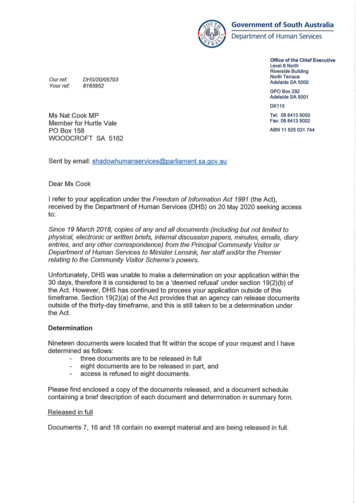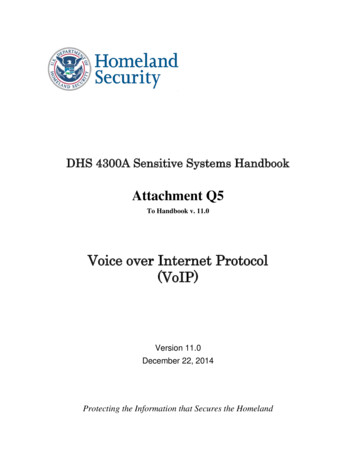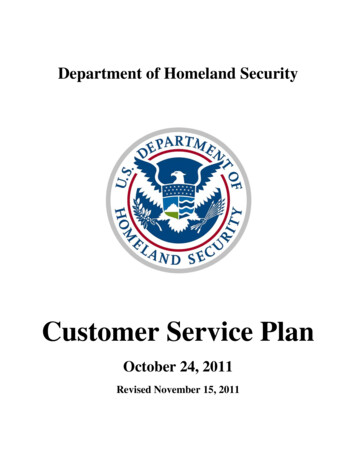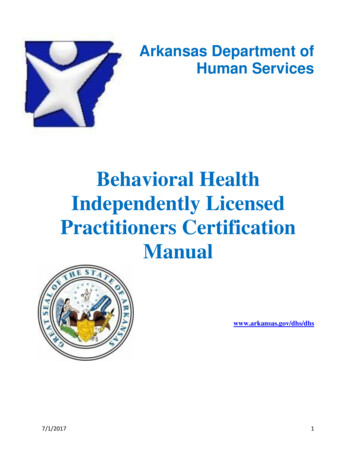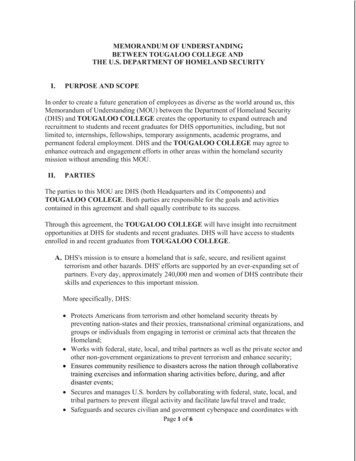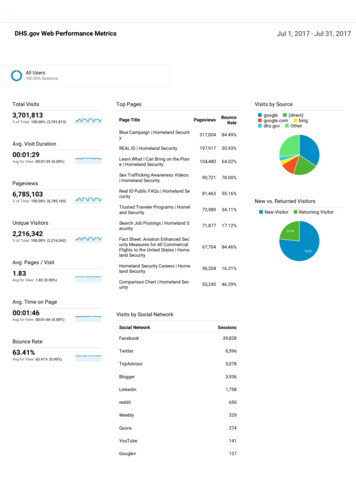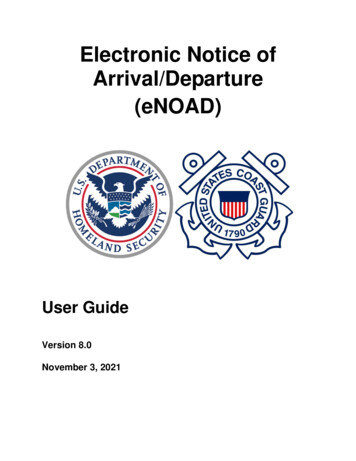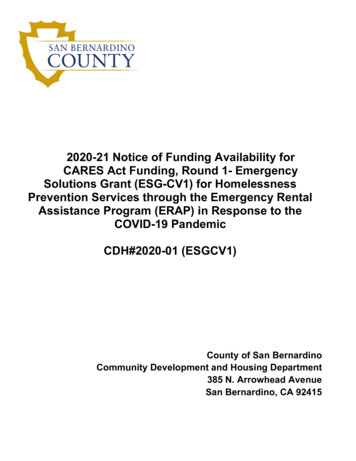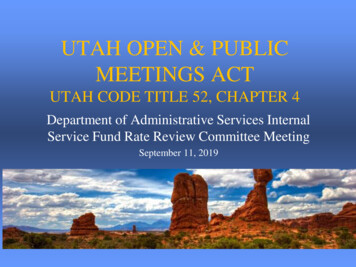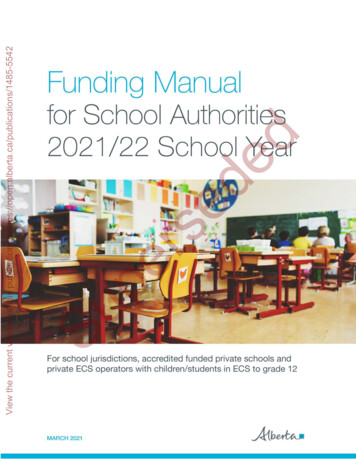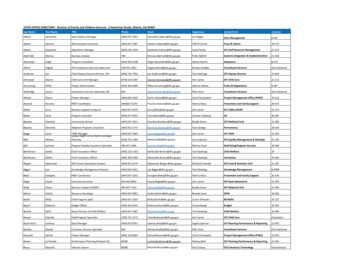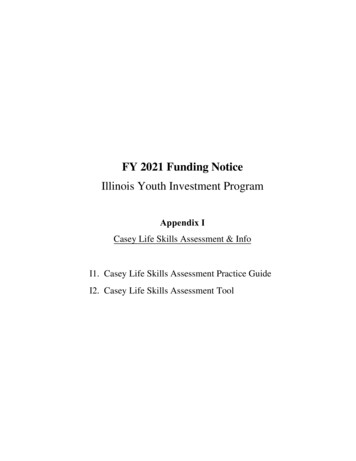
Transcription
FY 2021 Funding NoticeIllinois Youth Investment ProgramAppendix ICasey Life Skills Assessment & InfoI1. Casey Life Skills Assessment Practice GuideI2. Casey Life Skills Assessment Tool
casey life skillscasey life skills practice guideAppendix I 2Practitioners GuideThis practice guide gives users a quick overview of how to use the CaseyLife Skills website to assess youth’s knowledge, skills and abilities. Itincludes a high level look at the skill areas assessed in the Casey LifeSkills Assessment (CLSA), information about the importance of permanentconnections for older youth and a listing of other assessments available.It outlines a six-step framework for how to administer an assessment,determine a youth’s strengths and challenges through a meaningfulconversation, build an effective learning plan and help a youth gain usefullife skills. If you have questions about CLSA, please contact the Casey LifeSkills Assessment Team at cls@casey.org.How have you acquired life skills?If you’re like most adults, you’ve learned the most through experience. Classes can provideinformation and exposure on the cognitive level, but youth need the real world experience ofmanaging money, preparing food, preparing for a job interview, making a dental or medicalappointment, or opening a bank account to fully develop these skills . Youth need to internalize andpersonalize what they have learned and develop confidence about using the skill in the future.1What is the Casey Life Skills Assessment (CLSA)?The CLSA is: A free, online youth-centered tool that assesses life skills youth need for their well-being,confidence and safety as they navigate high school, postsecondary education, employmentand other life milestones. A measure of youth confidence in their future and their permanent connections to caringadults. Designed to be as free as possible from gender, ethnic and cultural biases. Appropriate for all youth ages 14 to 21 regardless of living circumstances (i.e., in foster care,with bio-parents, in group homes or other places). Comprehensive with 113 assessment items categorized within eight areas for skills,knowledge and awareness. Youth can complete one area at a time or finish the wholeassessment in approximately 30-40 minutes.The CLSA is not a test! It is a self-reporting instrument that gives youth and their caregivers the opportunity toassess their strengths and challenges. It promotes young people’s active engagement in planning their learning goals and makingdecisions (within the safety of adult mentoring) about their future.casey family programsSmith, W.B. (2011). Youth Leaving Foster Care: A Developmental,Relationship-Based Approach to Practice. New York: Oxford University Press.1
casey life skillscasey life skills practice guide The CLSA was designed for use with youth in foster care but can be useful for other youthinvolved in juvenile justice facilities, employment centers, homeless shelters or with othersocial service providers. The CLSA does not collect personal identification information and the results are keptanonymous in a secure database. The tool may help states meet the transition requirements of the Fostering Connections toSuccess and Increasing Adoptions Act. Fostering Connections requires that older youthin foster care be better prepared for adulthood and provides federal support for transitionprograms to age 21. The CLSA can also be a support tool for states’ Chafee Foster Care IndependencePrograms. These programs deliver instruction and services for young people in areas suchas obtaining a high school diploma or GED, career exploration, job placement, daily livingskills, money management and preventive health education, etc. Check with your state’sIndependent Living Coordinator to get more information on the Chafee benefits for whichyouth in care may be eligible (e.g., Education and Training Vouchers). http://www.nrcyd.ou.edu/chafeeWhat Areas Are Assessed in the CLSA?Life SkillsNumber of ItemsCompetencies Assessed17Meal planning and preparation, cleaning and foodstorage, home maintenance and computer andinternet basics.Self Care17Healthy physical and emotional development suchas personal hygiene, taking care of one’s health andpregnancy prevention.Relationships andCommunication18Developing and sustaining healthy relationships,cultural competency and permanent connectionswith caring adults.Daily Livingcasey family programs
casey life skillscasey life skills practice guideLife SkillsNumber of ItemsCompetencies AssessedHousingand MoneyManagement23Banking and credit, finding and keeping affordablehousing, budgeting and living within one’s means.Work and Study20Basics of employment, legal issues, study skills andtime management.Career andEducationPlanning9Planning for career and postsecondary educationpertinent to older youth.Looking Forward8Youth’s level of confidence and internal feelingsimportant to their success.20Embedded within all of the skill areas of theassessment are 20 items that assess a youth’sconnection to trusted adults, community of supportand overall interdependent connections. It isrecommended that practitioners pay attention tothese areas as young people need a strong safetynet of support as they learn the skills they need tomove to young adulthood.PermanencyTo preview the Casey Life Skills Assessment click here and go to page 3.Why does the CLSA emphasize permanency?Youth tell us, and Casey Family Programs believes it is best practice that every youth needs anddeserves to grow up in a safe and permanent family as well as a supportive community.Ideally, all youth who experience foster care will attain legal permanency, in which the youthis reunified with his or her biological parents, is adopted or lives with a legal guardian. Regardlessof the achievement of legal permanency, ensuring that youth establish permanent connections isessential to help them prepare for and succeed in adulthood. A permanent connection is a stable,lasting, unconditional, emotional and relational connection that one has with family members andsignificant others in their lives, whether or not the youth resides with them. When youth have trustingconnections with adults who care about them and their success, this gives them optimism andencouragement that they can grow and learn. When youth transition from the assistance providedby programs and services, permanent relationships continue and provide support.casey family programs
casey life skills practice guidecasey life skillsA young person’s permanent connections are assessed throughout the CLSA. In addition toassessing knowledge, skills and ability to access community resources, each skill area has one ormore statements to help determine if youth have trusted adults with whom they are actively engagedin an enduring relationship. For example, in the area of relationships, there is “I know at least oneadult I can depend on when I exit care.” In Housing and Money Management there is “I know anadult I could live with for a few days or weeks if I needed to.” Practitioners can use the CLSA toassess whether or not youth have a safety net of support underlying all the skill areas.It is essential for those who work with young people to help them establish meaningfullifelong connections with family members and other significant adults who will supportthem as they prepare for adulthood and beyond. This work is an essential part of eachyouth’s learning or service plan.For more information about foster care and permanency, please visit the Casey Family Programswebsite at www.casey.org. An additional tool to help youth develop a network of caring people isFosterClub’s Permanency Pact. FosterClub is a national network for young people in foster care.To access this free comprehensive checklist for youth go to www.fosterclub.com/files/PermPact.pdf.How to assess young people’s knowledge, skills and awarenessSTEP 1 Motivate youth to take the assessmentBe enthusiastic and positive about the assessment and its purpose. Make sure that youth knowthat it is not just a requirement or a test but a tool for them to use to learn what knowledge andskills they really need. Let them know that you and others will work with them to use the informationfrom the assessment to develop a plan to meet their wants and needs. Arouse their curiosityabout the results. Encourage active participation – invite them to share what they hope to get outof completing the assessment. Let them know this is an excellent opportunity for them to practicemaking decisions about their future—what they want to do tomorrow, next week, or next year.Be creative in administering the assessment to best engage the youth Youth can work at their own pace and work on one skill area at a time or they can completethe entire assessment in about 30 – 40 minutes. All of the Casey Life Skills Assessments are available in printable form, so they can becompleted in any location with the results entered into the computer later. You can printthem after logging into the website. For group work, peer-to-peer communication about the assessment can be a good methodof engagement. Let youth have experience with the computer! Computers run our world – youth need handson experience to keep up with technology that could help them stay in school, get a job, andattain other achievements. An alternative method is to use the assessment as an interview tool. Make it a conversationrather than having the youth sit at the computer. This can be especially helpful for youth withreading challenges or short attention spans.casey family programs
casey life skills practice guidecasey life skillsSTEP 2 Review the youth’s assessment resultsThe results will appear once the youth (or other person entering the data) clicks “Save Assessment.”The “At-A-Glance” page will show the youth’s name, their agency and their average scores. Theaverage score for each life skill area, including permanency, will be shown on a scale of 1 – 5, with 5indicating high strength. Practitioners can quickly see where a youth’s strengths are, as well as areaswith gaps in knowledge and proficiency. The next page of the assessment results will list all of thestatements for a particular skill area and the youth’s answers. Part of reviewing a youth’s assessmentresults is looking at how they answered each statement. See Step #4 for more information abouttalking to a young person about their assessment results.STEP 3 Invite caregivers in a youth’s life to complete an assessment(optional but recommended)Caregivers who know the youth (i.e., foster parents, social workers, teachers, etc.) can also assessthe youth’s strengths and challenges using the CLSA. Explain to youth and their caregivers howgetting this additional perspective can add to a rich conversation, open doors for productivecommunication that might not happen otherwise and gain additional “buy in” and support for theyouth’s learning plan activities (see more detail about including the caregiver(s) perspective in thefollowing steps).STEP 4 Let’s Talk--Engage youth in a conversation about the results of their assessmentShare a copy of the results with the youth for the conversation and let them tell you about what theresults mean. Start with the positive. Ask the youth to start by identifying their strengths—thoseareas where their average scores are closer to a 5. Then move to looking at lower average scores.Ask the youth where they felt unsure and where they think they need help – what is challenging forthem right now? Ask if there were any surprises for them in the results, if so, discuss why. The best expert on a youth’s knowledge and behavior is the youth. There will be exceptionswhere young people are incapable of self-reflection or self-perception because ofpsychological, physical or developmental challenges, and the additional perspective of acaregiver assessment is especially helpful. In most cases, however, youth are very capable ofoffering self-reports on what they know and can do. The cognitive development and life experiences of youth ages 14 – 17 years will be, mosttimes, behind that of their 18 – 21 year old peers. Practitioners can prepare younger youthto expect some items in Career and Education Planning, Work Skills and Housing andMoney Management to be out of their range of knowledge and experience. When reviewingthe scores for these more advanced skill areas with younger youth, you can remind themthat they simply haven’t had opportunities to gain experience in these areas yet. Use theopportunity to have them think about their futures. For example, draw connections betweentheir favorite school subjects or activities and how they can begin thinking about relatedpostsecondary training and education that will prepare them for careers that interest them.Remind them that learning simple budgeting techniques now will help them with moreadvanced money management skills in years to come. If a youth’s results are being compared with a caregiver’s assessment results, this shouldbe part of a conversation including both the youth and caregiver. Review the results thatcasey family programs
casey life skills practice guidecasey life skillscompare assessments between the youth and caregiver and facilitate a conversation aboutareas of agreement and difference. If the youth has taken the assessment before, compare results to previous assessmentresults. Again, start with the positive and first look for the areas of most improvement. It isimportant to note that sometimes a youth’s scores may be lower than their first assessment.They may have been overly confident in a particular skill, given answers because theythought they were the expected answers or simply guessed. Discuss why the scores are thesame or different. Ask the youth if they feel more or less confident in particular areas.For a more detailed description of The Conversation with suggested discussion guides click here.STEP 5 The conversation continues—Help youth develop learning plan goals and activitiesThe best and most effective learning or service plan is the one that a youth will actually implement.To get “buy in” develop the plan with active input from the youth and the results of their assessment.Let youth lead the way in determining which behaviors, knowledge or skills are most important tothem and choosing what learning goals they want to work on first. Some providers may have aservice plan that can be used to incorporate new goals and activities that youth want to work on. Ifnot, click here for a sample template.Including caregivers in the planning process will increase learning opportunities and support for theyouth. Even if the youth’s caregivers have not been involved in the assessment process, encouragethe youth to share the assessment, set goals and plan activities with them so that they, too, canprovide and support “real life” learning experiences.When considering which activities to include in a youth’s plan, talk to them about how they like tolearn. Then, with the help of the practitioner and caregiver, let the youth identify the steps to take tolearn or achieve something and how they will proceed with those steps. Remember to ask them howthey will know they have achieved success/knowledge/a particular skill and include that measure oroutcome in the plan. (click here for a description about learning styles and levels)Use the Resources to Inspire Guide click here to printThe resource guide is a reference for caregivers indexed by skill area. It lists goals, learningobjectives and a sample of youth-appropriate resources that may be useful additions to a youth’splan. It is written to complement a developmental approach to learning. Practitioners can copythe content into their service plans or into the template provided on the CLS site. Almost all of theresources listed are free or very low cost and many are printable PDFs.The resources can be used in group, individual or self-instruction formats. For group learning, try anicebreaker or game activity that will assist youth with learning about goals, practice setting simplegoals and inspire them to identify areas of interest. What do they want to tackle first?The resources offered are suggestions. We encourage practitioners to use Google or similar searchengines to find resources in their geographic area or to use resources specific to their child welfaresystem or agency.casey family programs
casey life skills practice guidecasey life skillsSTEP 6 Help youth implement, monitor and update their learning planUse the plan. Bring it out or refer to it in your interactions and communications with the youth andcaregiver. Ask about progress. Celebrate successes! If youth fail in a task, use it as a teachablemoment and encourage them to try again. Ask what’s working and what’s not (be prepared to hearthe truth) and modify the plan, activities and supports accordingly. It is critical that young peoplepractice new skills in the real world on an ongoing basis; help provide these opportunities.Use the CLSA to chart progress and set new goals. Formally review the learning or serviceplan at regular intervals and update the plan with new goals and activities. Sections of the CLSAcan be used alone as a post-assessment if the youth has focused on increasing skills or abilities in aparticular area, or the entire assessment can be retaken to assess total progress over a longer timeinterval. Intervals between pre/post assessments can vary from monthly to quarterly to annually. Itdepends on the youth’s needs, the service provider’s IL program requirements, and a jurisdiction’scompliance requirements.Information about the Looking Forward section for practitionersThe items in the Looking Forward section of the CLSA are intended to represent a desiredfuture state or eventual place you are trying to move youth toward. They strive to help articulatethe eventual outcome you are striving for your youth if the ‘intervention’ or other methods/trainings succeed.These items are not behavioral. They are about internal feelings or overall readiness. Therefore, theyare not aggregated or reported in the same way as the skill area items. The Looking Forward itemsare meant to tell you more information about the youth than what is visible or teachable. It is theadded level of confidence and internal feelings that will help them to be successful.For more information on interpreting the results of the Looking Forward section with young peopleand using the information in their learning plans click here.Other assessments available for populations with particular characteristicsor circumstancesIn addition to the CLSA, there are more assessments available to help practitioners and caregiversattend to life skills relevant to youth with particular characteristics or circumstances, such asAmerican Indian, homeless, and GLBTQ youth. Click here to access a list of these assessmentsand brief descriptions. Healthy Pregnancy Parenting Infants Parenting Young Children Youth Assessment Level I (elementary ages) Youth Assessment Level II (middle school ages)casey family programs
casey life skills practice guidecasey life skills Gay, Lesbian, Bisexual, Transgender and Questioning Youth Homeless Youth American Indian Education: Upper Elementary School Education: Middle or Junior High School Education: High School Education: Postsecondary or Training Educational SupportsImportant resources for practitioners Foster Club’s Transition Toolkit: www.fosterclub.com/files/transition toolkit v3.pdf Foster Club’s Permanency Pact: www.fosterclub.com/files/PermPact 0.pdf Youth Leaving Foster Care: A Developmental, Relationship-Based Approach to PracticeAuthor: Wendy B. Smith The Adolescent Brain: New Research and Its Implications for Young People TransitioningFrom Foster Care (2011): ull-reportRetention policyCLS assessments are retained in the online database for two years after they are last modified.You may download, save and/or print these assessments for longer retention as needed.casey family programs
casey life skills privacy policyAppendix I 2CaseyLifeSkills.org’s Privacy Policy is designed to assist you in understanding how the CaseyLifeSkills.org Web site (CaseyLifeSkills.orgor Web site) collects and uses the personal information you or someone with your permission (the User) provides to the Web site, andto assist you in making informed decisions when using CaseyLifeSkills.org and the content, materials, products and services availablethrough the Web site. Because the Web is an evolving medium, it may be necessary to change this Privacy Policy from time to time, inwhich case, the revised Privacy Policy will be posted on the Web site.What Information Does Casey Life Skills Collect?When the User visits CaseyLifeSkills.org, brought to you by Casey Family Programs (Casey), the User may provide two types ofinformation: (1) personal information you knowingly choose to disclose that is collected on an individual basis; and (2) Web site useinformation collected on an aggregate basis as the User and other users browse the Web site.Personal Information You Choose to Provide to the Casey Life Skills Web siteRegistration InformationThe User may provide the Web site with information about yourself and your practices when you or someone withyour permission elects to register on the CaseyLifeSkills.org and thereafter participate in any activities available on the Web site.Email InformationIf the User chooses to correspond through the Web site, Casey may retain the content of any of the Users electronic messagestogether with your contact information and any user responses.Web Site Use InformationSimilar to other Web sites, CaseyLifeSkills.org utilizes a standard technology called “cookies” (see explanation below, “What AreCookies?”) and Web server logs to collect information about how the Web site is used. Information gathered through cookies and Webserver logs may include the date and time of visits, the pages viewed, time spent at the Web site, and the Web sites visited just beforeand just after our Web site.What Are Cookies?A cookie is a very small text document or file, which often includes an anonymous unique identifier. When a user visits a Web site, thatWeb site’s technology asks the user’s computer for permission to store this file in a part of the user’s hard drive specifically designatedfor cookies. Each Web site can send its own cookie to the user’s browser if the users browser’s preferences allow it, but (to protect theusers privacy) the user’s browser only permits a Web site to access the cookies it has already sent to you, not the cookies sent to youby other sites.How Is Information Collected From Cookies?Cookies, in conjunction with the Web server’s log files, allow Casey to calculate the aggregate number of people visiting CaseyLifeSkills.org and which parts of the Web site are most popular. This helps Casey gather feedback in order to constantly improve CaseyLifeSkills.org and better serve Web site Users.Data Collection & ReportsThe data and information the User supplies on any electronic form, paper form, application or request for information, may be collectedand tabulated for statistical and reporting purposes and those results may be provided to other organizations or individuals, but you willnot be identified by name in those results.No representation is made or any warranty given (either express or implied) as to the completeness or accuracy of the data or reportsand of the contents contained therein. It is the responsibility of the Web site User to verify information and satisfy himself/herself beforeacting upon it. Any action taken based on the data and reports is entirely made at the sole discretion and at the own risk of the User.Communicating With Third PartiesThe User may communicate with third (3rd) parties on CaseyLifeSkills.org at the User’s own risk. Casey does not control, and is notresponsible for the actions of other users or third (3rd) parties with whom the User may choose to share your information.Casey encourages CaseyLifeSkills.org Users to be aware when they leave Casey Life Skills and to read the privacy statements of third(3rd) party Web sites. This Privacy Policy applies solely to information collected by Casey.Security DisclaimerWhile Casey strives to maintain a Web site that safeguards your information and enhances the User’s use, electronic communicationsover the Internet, whether via e-mail or otherwise, are not secure and your privacy cannot be guaranteed. CASEY EXPRESSLYDISCLAIMS ANY RESPONSIBILITY FOR ANY HARM, DAMAGE OR OTHER INJURY THAT YOU MAY EXPERIENCE OR INCUR BYSENDING OR GIVING PERMISSION TO SEND PERSONAL OR CONFIDENTIAL INFORMATION VIA ELECTRONIC MEANS.Unsubscribing from Email ListsTo unsubscribe from CaseyLifeSkills.org email lists, simply click on the unsubscribe link at the bottom of any email from Casey.casey family programs
casey life skills terms of useGeneralCaseyLifeSkills.org contains material which is derived in wholeor in part from Casey Family Programs (Casey) and othersources. CaseyLifeSkills.org and its content are protected byinternational copyright, trademark and other intellectual propertylaws. You may not modify, copy, reproduce, republish, upload,post, transmit or distribute in any way any content or contentor material from this Web site, including code and software forany commercial purposes. You may only download content ormaterial from this Web site for your personal, non-commercial useonly, provided you keep intact all copyright, licensing terms of useand other proprietary notices.Casey agrees to provide you access to Casey Life Skills subjectto these Terms of Use. You agree to use Casey Life Skills inaccordance with these Terms. Because the Web is an evolvingmedium, it may be necessary to change these Terms of Use fromtime to time, in which case we will post the revised Terms of Useon Casey Life Skills. By continuing to use Casey Life Skills afterany such changes are posted, you accept the Terms of Use, asmodified.DefinitionsBy “us,” “we” and “our” we mean Casey Family ProgramsBy “user” and “you” we mean a person visitingCaseyLifeSkills.orgBy “Web site” we mean CaseyLifeSkills.org“Content” or “materials” includes, but is not limited to, any formsof text, images, video, graphics, software code, multimedia files,design, photographs, illustrations, animations, audio, and audiovisual material, art, proprietary information, data, databases,service marks, trademarks, trade names, distinctive identificationsuch as logos, the selection sequence, “look and feel” andarrangement of items.Other Referenced OrganizationsOther referenced organizations on the CaseyLifeSkills.org websitedoes not indicate the existence of a legal partnership, joint agencyor other relationship indicating or involving shared ownershipor shared liability between Casey and such other organizationsmentioned on CaseyLifeSkills.org. Neither Casey nor the otherreferenced organizations have any authority to assume or createany obligation on behalf of the other party.Intellectual Property OwnershipThis Web site contains a combination of content that Caseycreates and owns, or that other organizations or other userscreate and post. All content and materials published on the Website including but not limited to text, images, video, graphics,software code, multimedia files, design, photographs, illustrations,animations, audio, and audio visual material, art, proprietaryinformation, data, databases, service marks, trademarks, tradenames, distinctive identification such as logos, the selectionsequence, “look and feel” and arrangement of items and allcopyrightable or otherwise legally protectable elements of theWebsite are protected by all applicable U.S. federal and statelaws and regulations, as well as applicable foreign laws andtreaties. All content and materials are the property of and areowned by Casey, or is content that Casey has a license to usepursuant to these Terms of Use. All rights in the content areexpressly reserved by the applicable copyright and trademarkowner.License to CaseyWhen you post a message, upload a file, or otherwise provideus with content or material for display on Casey Life Skills, youare granting Casey a royalty-free, perpetual, non-exclusive,unrestricted, worldwide license to:use, copy, sublicense, adapt, transmit, publicly perform or displayany such communication and content; andsublicense to third parties the unrestricted right to exercise any ofthe foregoing rights granted with respect to the communicationand content.The foregoing grants shall include the right to exploit anyproprietary rights in such communication, including but not limitedto rights under copyright, trademark, service mark or patent lawsunder any relevant jurisdiction.By providing content or materials to CaseyLifeSkills.org, youhereby represent and warrant that the content or materialsand any use of said content or materials on the Web site and/or by Casey does not infringe upon any third (3rd) party rights.Furthermore, you hereby agree to indemnify, defend and holdharmless Casey for all losses, damages, claims, actions, andcosts (including attorneys’ fees) caused by or arising from useof such content or materials in any way connected to the Webcasey family programssite or use by Casey. The terms, conditions and warrantiescontained in this section shall survive the modification, expirationor termination of the Terms of Use.PrivacyUnless otherwise indicated, Casey may collect personalinformation from users of CaseyLifeSkills.org, including but notlimited to, registering users to the Web site. Casey uses suchcollected personal information to provide better services toCaseyLifeSkills.org. Please see Casey’s Privacy Policy for moreinformation.DisclaimerCasey may provide links or Web site addresses to other Websites merely for your convenience. Cas
ou.edu/chafee What Areas Are Assessed in the CLSA? Life Skills Number of Items Competencies Assessed Daily Living 17 Meal planning and preparation, cleaning and food storage, home maintenance and computer and internet basics. Self Care 17 Healthy physical and emotional development such as personal hygiene, taking care of one's health and
